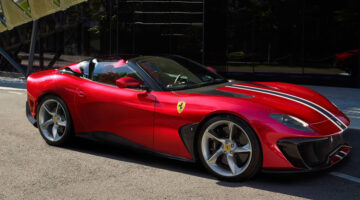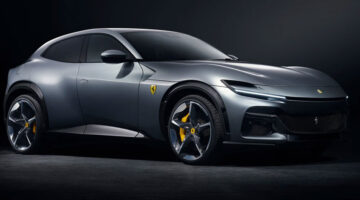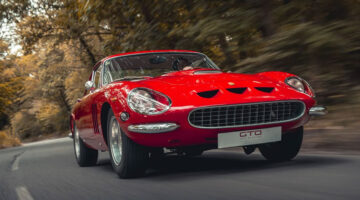The results though spoke for themselves: with an F1-derived engine, suspension, chassis and scientifically optimised aerodynamics, the F50 truly was the ultimate supercar, and it wasn’t long before all 349 examples had been sold off for a cool half million dollars a pop. In just three years. Amazing to think that the F50 – which was also available in colours other than Scuderia red for the first time – is rarer than the F40. Even more astonishing to think that, considering the facts laid out here, the F50 remains Ferrari’s underrated supercar. And there are a few good reasons for that.
One was the McLaren F1. The first supercar designed by Ferrari’s arch-Formula 1 rivals was a runaway hit, blending a fine line between astonishing looks (plus a centre-mounted driver seat), superb performance and gut-wrenching power: the F1’s top speed of 372kph made it the fastest production car on the planet. It wasn’t difficult to guess which supercar was the playboy’s machine of choice and which had been left in the shadows. Indeed, on sheer grunt (all that mattered, apparently), the F50 was outmatched by the F1’s 6.1-litre V12, and even lost out by more than half a second from 0-100kph to the F40 it was replacing,
Then there was the racing programme. An F50 GT1 did eventually make it to production, but none of the three chassis was ever raced, Ferrari pulling out of the BPR Global GT Series (a forerunner to the FIA GT Championship) at the eleventh hour. In a bitter twist, both BPR championships awarded in 1995 and 1996 were won by the McLaren F1 GTR, which also added victory at Le Mans in 1995 to an already impressive trophy case in Woking. Like this example shot recently at the Bahrain International Circuit, the F50 was destined to remain a track day toy.
It’s difficult to peg an exact reason for the F50’s anonymity compared with its rivals (to call it a failure would be harsh, since half a million dollars multiplied nearly 350 times does buy a lot of Formula 1 gearboxes), but many have speculated that the mid-1990s was perhaps just not the time for Formula 1 to hit the roads. Indeed, given Ferrari’s F1 record at the time – between 1991 and 1995 the team secured only two victories– attempts to advertise their on-track performance was at best mistimed. Next year though Ferrari once again goes up against McLaren on super/hypercar turf: LaFerrari versus P1. Twenty years is a long time, but it’s a racing certainty Ferrari won’t be looking to slip out of the limelight again.
– Shots courtesy of M7M Photography
| Ferrari | F50 (as of 1995) | |
|---|---|---|
| Engine: | V12 / 4700cc / DOHC per bank | |
| Power: | 520hp @ 8000rpm | |
| Torque: | 327lb ft @ 6500rpm | |
| Transmission: | Six-speed manual / rear-wheel drive | |
| Front suspension: | Double wishbones / pushrod-operated coil-over dampers | |
| Rear suspension: | Double wishbones / pushrod-operated coil-over dampers | |
| Brakes: | Vented / cross-drilled discs / Brembo four-pot calipers | |
| Wheels: | 8.5-in x 18-in (front) / 13-in x 18-in (rear) | |
| Weight (kerb) | 1350kg | |
| 0-100kph: | 3.7 secs | |
| Top speed: | 325kph approx. | |
| Basic price: | Quite a bit |



